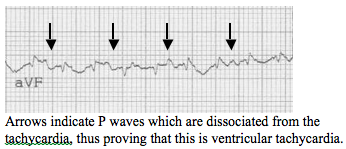
50-year-old man with palpitations and chest tightness.
Interpretation & Explanation
This rhythm is a regular wide-complex tachycardia. By definition, this rhythm is ventricular tachycardia until proven otherwise. Fully 70% of WCT is v. tach. Other causes of WCT include SVT with 1) rate-related changes (aberrancy), 2) pre-existing bundle branch block, or 3) antidromic conduction down a bypass tract (WPW).
Some electrocardiographic clues that suggest ventricular tach include QRS concordance (QRS complexes in chest leads all predominantly negative or positive), very wide QRS complexes (eg QRS > 160 msec with LBBB), extreme right axis (-90° to ±180°), and evidence of AV dissociation.
While there are many criteria for predicting v. tach, clinical association is as good as any electrocardiographic criteria. If the patient has a cardiac history, it is v. tach 97% of the time! (Lift up the hospital gown and look for the sternotomy scar!)
And in an emergency, treat wide-complex tachycardia (WCT) per current ACLS protocols.
